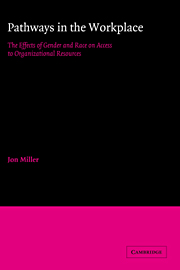2 - Ascription, achievement, and network centrality
Published online by Cambridge University Press: 30 September 2009
Summary
There are three stages in the analysis of network centrality.
1. In the first stage, the effects of gender and race are compared with the effects of those variables that were used as indicators of achievement or formal organizational position, including formal training, professional experience, occupation, workplace location, and formal authority, or rank. The effects of age are also taken into account. The hypothetical, ideal-typical reference point here is simply stated: In a purely rational situation, the advantages of the work setting would not be allocated differentially along the lines of gender and race, but rather according to objective professional investments and contributions to the system's activities. Therefore, the effects of achievement-related variables such as those I have included ought to out-weigh by far the effects of ascription. A comparison of mean network centrality across race and gender categories, together with a simple regression of centrality on race, gender, and the various indicators of objective achievement, addresses this proposition.
2. By itself, this first step in the analysis is insufficient. Simply indicating whether women or men, whites or nonwhites have greater network access does not rule out the possibility that different mechanisms for achieving centrality are in operation for different categories of participants. Regardless of whether a woman has more or less access to informal channels, what she has to do to gain that access may be very different from what a man does; similarly, whites may draw upon strategies that are quite different from those available to nonwhites. In other words, ascribed attributes may condition the effects that achieved characteristics have on determining the advantages gained by individuals.
- Type
- Chapter
- Information
- Pathways in the WorkplaceThe Effects of Gender and Race on Access to Organizational Resources, pp. 27 - 60Publisher: Cambridge University PressPrint publication year: 1986

